Canon EOS 5D Mark III Review
A few months ago when I wrote my thoughts on the Canon EOS 1DX, I wondered if 2012 could be the year where Canon makes a serious comeback in the professional photography industry. Some of what I wrote back then:
For the last 4 years I’ve been bashing Canon here on my blog for their poor quality control, poor product releases (50D, 5D Mark II, 7D, 60D) and questionable business practices (5D Mark II, 50mm f/1.2L). I’ve also often mentioned how it seemed like Canon was out of touch with the market and didn’t listen to what professionals were asking for. But with the announcement last year of the EOS 1DX, I think I’m starting to see the long awaited change we’ve been asking for.
Little did I know how much I would be blown away just a few months later when the Canon EOS 5D Mark III was announced along with an entirely new Speedlite system with RF (Radio Frequency) based wireless triggering capabilities. With all the new products in the EOS range that Canon has announced and is still going to announce this year, I really feel excited again to be using Canon equipment. Once again Canon not only has the most complete lineup of lenses, but they also have bodies capable of delivering great images and video. In fact, when you look at the entire EOS range for stills and since recently also for video, and the way in which you can mix these products and use them together, you quickly realize that Canon has an unbeatable ecosystem of professional products for creatives. Nobody else in this industry comes even close.
This review is going to be a long one as I have a lot of things I want to discuss, but for those of you who want the short version, I can tell you just stop reading and go buy the 5D Mark III. You will not be disappointed. In all honesty I can say that the 5D Mark III is currently the best DSLR on the market, apart from the 1DX. It’s a work of art. I bought two myself. And if you’re wondering about the Nikon D800, I can tell you that the 5D Mark III is a much better choice. I wouldn’t buy the D800 even if it was priced at $2000 and the 5D Mark III was still $3500. That is how good the 5D Mark III is. If you think I’m biased, think about the fact that I have recommended the Nikon D700 in the past instead of the 5D Mark II.
Back when the 5D Mark II came out, I was one of the first persons, if not THE first, who pointed out that the autofocus system on that camera was too old and too inadequate for a camera like the 5D Mark II:
With the release of the EOS 5D Mark II camera by Canon recently, I have begun to wonder if the people in charge at Canon’s DSLR division know anything about photography at all. This camera had the potential of becoming a great hit for many different types of photography. But as it is now, it will only be really useful for studio and landscape photography, unless you can put up with its shortcomings.
One of the biggest problems with this camera is its old and outdated autofocus system. It appears Canon just took the 3 year old autofocus system from the old 5D, made some minor changes and put it into the 5D Mark II. The autofocus system has 9 autofocus points, of which ONLY ONE (the center one) is a crosstype point, sensitive at f/2.8. The other 8 surrounding points are less sensitive, being only horizontal-line sensitive at f/5.6.
This is a huge problem for event photographers and journalists who are looking to use this camera, but even studio photographers who want to use autofocus. In low light situations, it’s going to be a real problem using the 8 outer autofocus points to focus on a subject. Many people have complained in the past about the slow autofocus using the outer points on the old 5D, and you would have expected that Canon would have listened and made improvements.
—
So now you have a high resolution sensor, 21 megapixels, but guess what? You can’t easily take pictures that are in focus, eliminating the entire point of having that much resolution available! So now you have a sensor that is extremely capable for low light, high ISO photography, but guess what, you can’t quickly and accurately focus in low light conditions. But hey, you can shoot HD quality video!
When I wrote that, the camera was just announced and not even shipping yet. However, I could already see what was going to happen when it got out and people would start using it. It’s interesting to read the comments again in all my posts about the 5D Mark II, and see how in the beginning I was vastly outnumbered by people who thought I was wrong. But as people started using the camera in the following months, the issues with the autofocus system and soft pictures became painfully evident to a constantly growing number of photographers. The autofocus system on the 5D Mark II became famously known as an “out of focus system,” and along with the 1D Mark III it became somewhat of a running joke in the industry that Canon cameras couldn’t focus. Photographers like Zack Arias and others would frequently make jokes about it in blog posts and during workshops. Even Vincent Laforet, who single handedly launched the video hype around the 5D Mark II with his short film Reverie, would later mention, albeit in a more diplomatic way, that the autofocus system on the camera was old and in desperate need of replacement. Other well known photographers who complained about the 5D Mark II AF system include Lise Gagne, Thom Hogan and Ryan Brenizer. Many photographers who upgraded from the first 5D to the 5D Mark II were disappointed and many of them switched to the Nikon D700. I have documented some of these cases here on my blog. Fake Chuck also reported many of them and some comments from other photographers can be seen here and here. Not surprisingly, the people who were complaining the most about the poor autofocus system and image quality issues on the 5D Mark II were professional photographers who demand a lot from their equipment.
Not long after my initial post on the 5D Mark II autofocus system, Canon Inc.’s Masaya Maeda made an appearance on DPReview where he claimed that Canon couldn’t add a better autofocus system to the 5D Mark II because the body was too small to house a better one. I seem to have been the only one who wrote about this absurd statement, and the online press largely ignored it:
One of the most obvious cases of cluelessness or blatant lying can be seen in this part of the interview:
One of the most common complaints we’ve seen about the 5D Mark II is that it still has the same AF system as the original 5D. Why is this?
“Firstly the market’s evaluation of the 5D’s AF system has been very positive; there have been no complaints from users, with everyone saying it’s very good. Given that, to a certain extent, we think we shouldn’t change it. And also there’s some limitation with size; the AF sensor in the 50D is very big; the one in the 5D is much smaller. If we wanted to have all cross-sensors in the 5D Mark II, it would mean we might have to sacrifice the compactness of the body. It’s all a question of balance of features and benefits.”
This answer is simply a serious insult to our intelligence. Nothing more. It looks like Canon, in all its arrogance, thinks its users are so stupid they can tell them anything they want to. First take note of the fact that the DPReview question started by telling Mr. Maeda that “one of the most common complaints we’ve seen about the 5D Mark II is that it still has the same AF system as the original 5D.” If the 5D Mark II AF system was so good, as Mr. Maeda wants us to believe, then why would people be complaining about it not being improved in the 5D Mark II? This doesn’t make sense, ofcourse, but Mr. Maeda seems to be lacking the intelligence to understand this.
Maybe Mr. Maeda would care to explain to us how it is that the EOS 50D, which is roughly the same size as the EOS 5D Mark II, is still able to hold the “very big” AF sensor which can’t fit in the 5D Mark II. Maybe Mr. Maeda would care to explain to us, how it is that Nikon was able to include a 51-point AF sensor in the D700 an D300 cameras, which are roughly the same size as the EOS 5D Mark II. Maybe Mr. Maeda would care to explain to us, how much more room Canon would need to put an AF sensor like the one in the 50D in the 5D Mark II. 2cm? 3cm? Would it have hurt to make the 5D Mark II body 2cm wider to house a better AF sensor? Perhaps Mr. Maeda would also like to explain how it is that he heard no complaints from users, when the Internet is literally filled with complaints about the old 5D autofocus inaccuracy, especially of the outer focus points. The level of cluelessness and arrogance here reaches astounding levels.
—
I hope Mr. Maeda reads all of these posts and can get in touch with reality soon. What is going to make all of this even worse, is when Canon will be releasing the 5D Mark III in the future, or a similar sized body, with a much better AF sensor, something that is bound to happen. In hindsight, Mr. Maeda’s answer is going to look even more ridiculous.
And indeed today we have a 5D Mark III that is roughly the same size as the 5D Mark II, with a vastly more advanced autofocus system, proving how ridiculous Maeda’s claims were.
I spent countless hours blogging about the 5D Mark II and its issues, as well as issues on other cameras from Canon over the last 5 years. I ran email campaigns and literally spammed Canon executives and media all over the world with my complaints and criticism for years. I even got in trouble with Bryan Carnathan from The Digital Picture which got sorted out after photographer John Harrington intervened, and Phil Askey from DPReview who thought I “clearly have an axe to grind against Canon” and sent his lawyers from Amazon after me.
Years ago I wrote a very angry email to Microsoft CEO Steve Ballmer where I criticized some of Microsoft’s strategies at the time. Much to my surprise he personally replied to me within a day thanking me for my email. I didn’t even expect a reply, much less one thanking me for all the criticism. And I think this reveals one of the important reasons why Microsoft is so successful: They know how to take honest criticism and act on it to improve. And I can say the same thing about some executives at Canon, most notably Chuck Westfall from Canon USA. I’ve criticized Chuck personally in the past, sent some angry emails to him and others at Canon, but to this day Chuck still replies to me when I give feedback and helps me if he can. Everything people say about Chuck’s generosity and knowledge on the Internet is true. And I think it’s because of people like Chuck Westfall at Canon that today we’re seeing Canon making a huge comeback in this industry with products such as the 5D Mark III.
When I look at the recent product launches starting with the 1DX, it amazes me how much of the things we asked for are turning up in the new products. With the 1DX, Canon actually went full frame and scaled back on the megapixels (something many photographers were asking for) and instead focused on speed and image quality. With the 5D Mark III, Canon essentially did the same. Fake Chuck ran a petition with feature requests (actually they were demands) for the 5D Mark III, and it’s remarkable how many of those features turned up in the 5D Mark III.
The sensor resolution remained roughly the same at 22MP, while they included the latest technologies (gapless microlenses etc.) on the sensor and improved the image quality instead. Compared to the 5D Mark II, the 5D Mark III has cleaner looking image quality (about 2 stops less noise), sharper images and the pattern noise and banding issues have been greatly reduced. To be sure, images from the 5D Mark III still suffer from pattern noise and banding mostly in the dark areas, but you only see it when you push the exposure in post. This is still something Canon needs to fix and this has been an issue in all Canon DSLR sensors at least since the EOS 40D. It’s probably an issue that is inherent to Canon’s current CMOS sensor designs. I’m hoping that Canon will find a way to completely eliminate this issue in future sensors and hopefully by the time the next 5D hits the market (or even before that) it won’t be an issue anymore. At Sony they appear to have a better sensor design as evidenced by the sensor used in the Nikon D800, which has no pattern noise and banding issues even while significantly pushing the exposure of an image in post. The noise in the dark areas of an image still looks pleasing to the eye. Canon needs to take notes here from Sony.
With the new DIGIC 5+ processor come features such as in-camera HDR and more importantly in-camera lens correction (chromatic aberration correction etc.). Especially the lens correction features are a huge benefit to the overall image quality you get with the 5D Mark III. I also like the fact that I can set up the camera so that pressing the magnify button while reviewing pictures automatically takes me to the autofocus point that achieved focus at actual size so that I can quickly check if the image is in focus. Speaking of the magnify button, Canon moved the button from the upper right corner to the left of the LCD, and it took some getting used to for me as I would constantly press the wrong button to try to zoom in. But after using the camera for a while I’m now used to the new location. I also like the new rate button, so I can rate an image while reviewing them with a client for later reference. Very very handy.
The 5D Mark III got the same 63-zone dual-layer metering sensor from the 7D which works together with the AF system to make sure the subject that’s in focus is well exposed. However, my experience is that this doesn’t always work reliably. Sometimes images turn out darker than I would expect them to be, and when taking a few shots of the same subject while nothing in the scene changes, you can get a darker image in between. Fortunately the metering system works reliably most of the time (95%). Canon also added the ability to take multiple exposures in a single image and increased the amount of exposure bracketed shots to 7 (up from 3), which is also something I wanted for a long while now.
When I learned that the 5D Mark III would get the same 61-point AF system from the 1DX, I was blown away. I would have been satisfied with the same AF system from the 7D, but Canon went much further by including the AF system from the 1DX on the 5D Mark III. This is a huge improvement on the 5D Mark II and this alone justifies an upgrade if you own a 5D Mark II. This new 61-point AF system with 41 cross-type points is extremely fast and accurate and can even focus down to EV -2 which is equivalent to shooting in the light of the full moon (center point with f/2.8 lens). The autofocus points also cover a large area of the frame, allowing you to frame the exact composition you want at the time of taking the picture. You can even configure the multi-controller to be able to select the autofocus point that you want to use at any time.
What I really love about the AF system is that although it is very complex, Canon has simplified it a lot by including presets for various shooting conditions. You can customize many of the AF functionality to suit your exact needs. Ever since I started using the 5D Mark III, even using a 50mm f/1.2 L lens between f/1.2 and f/2, I hardly get any out of focus shots. Based on my experience so far, I would say that less than 5% of my shots are out of focus. It’s simply incredible. You have to keep in mind that I am very critical when it comes to focus issues, and this was one of the main things I complained about in the past. Now, with the 5D Mark III, I couldn’t be happier.
Not only is the AF system fast, but even the camera reacts much faster with a shutter lag of 59ms (almost the same as 55ms on the 1DX). I will never forget the first time I pressed the shutter button on my 5D Mark III. I gently touched the shutter button and the camera instantly focused and took the shot even before I had a chance to think about it. It’s a world of difference between what I was used to on previous cameras from Canon that I used (40D, 7D, 5D Mark II). I feel so much more in control with the 5D Mark III and feel so much more confident using the camera. Canon also updated the lens microfocus adjustment feature of the AF system, and it is now able to detect the serial number of the attached lens so you can configure settings specific to that lens. So even if you own, for example, two 50mm f/1.2 L lenses, you’ll be able to configure different focus adjustment settings for each one. Previously this wasn’t possible.
The below review by The Camera Store shows how the 5D Mark III autofocus system even outperforms the Nikon D800.
Apart from the fast AF system, the maximum frame rate has also been increased to 6fps (up from 3.9fps on the 5D Mark II). While it’s not bad, I would have preferred at least 8fps. A welcome new feature is the silent shooting mode, where the speed drops to 3fps while the shutter operates very quiet. The shutter durability has also been increased to 150.000 shots. You can now also change the filenames and specify your own custom names on the camera. This custom filename feature also comes with a new firmware update for the EOS 7D and is one of the things Fake Chuck asked for a while ago.
For some reason the 5D Mark III feels so much better and so much more balanced in my hands compared to the 7D. It feels very solid in my hands and comfortable to hold, thanks to the way Canon placed the rubber grips on the camera. I’m not a fan of battery grips as it makes the camera that much bigger and heavier, so I’m happy with the fact that I can comfortably use the camera without one. I have to admit that it still doesn’t come close to, for example, the Nikon D200/D300/D700 etc. in this area.
I’m currently not much of a movie guy myself, although I have been fooling around with the movie recording feature on the camera. So I can’t comment on the movie recording functionality of the camera much. But from the reviews done by others such as Philip Bloom, I am convinced that the 5D Mark III is the better choice for video compared to the Nikon D800 and even the Nikon D4. Check out the below comparison by Philip Bloom.
Compared to Nikon D800
As far as I’m concerned, the 5D Mark III is clearly the better choice compared to the Nikon D800. The images from the 5D Mark III are cleaner with less noise and JPEG images also appear to be sharper compared to the Nikon D800. Even the video quality is better on the 5D Mark III, as can be seen in the reviews I linked to above (for example the one done by Philip Bloom). There’s less noise at high ISO values, and there’s also no moiré and aliasing on the 5D Mark III, where this is an issue on the D800. I don’t know what got into Nikon to go all the way to 36MP on the D800. This is clearly an example of how you shouldn’t be doing something just because you can. Even Nikon users have indicated that they would rather have seen the 16MP sensor from the D4 in the D800, as can be seen from the poll below done by Nikon Rumors a few months ago.
The extra resolution you get going from 22MP to 36MP isn’t worth the issues that come with that jump in resolution. For one, there is a lot more noise in images as can be seen from the screenshot below taken at DPReview.
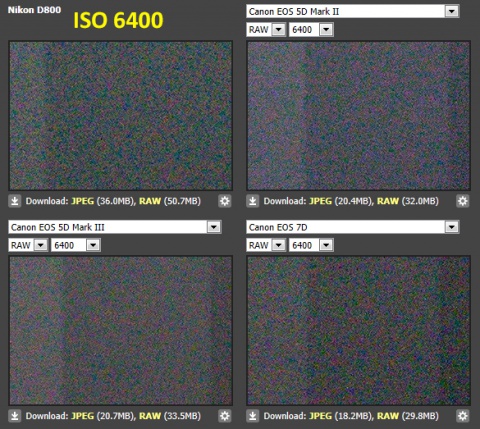
5D Mark III VS D800 at ISO 6400. Source: DPReview.
You can clearly see that even the 5D Mark II image quality is better than the D800. The difference with the 5D Mark III appears to be almost 2 stops. And the noise on the D800 is an issue at all ISO values except perhaps ISO 100. I’ve seen ISO 320 pictures from the D800 with so much noise I thought it was probably ISO 1600. It’s just awful. In contrast the images from the 5D Mark III are much smoother and cleaner. Here’s another example with JPEG images taken from Camera Labs.
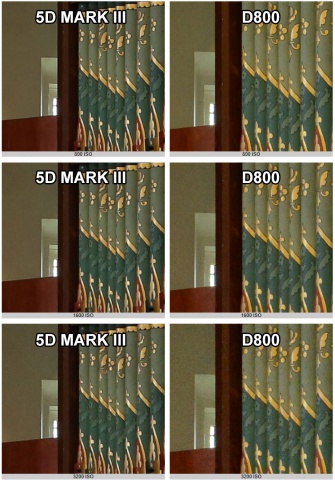
5D Mark III VS D800. Source: Camera Labs. (click image for larger view)
As you can see, again the D800 image quality is worse; there’s more noise while the images also look softer with less detail even at the higher 36MP resolution. This is probably due to the noise reduction that is going on inside the D800 to make the images look better with less noise. But this happens at the expense of image sharpness. This is a clear example of how the extra resolution on the D800 is pointless when there’s also more noise present. You’re going to have to apply noise reduction and this eliminates the advantage you had in resolution making all the extra megapixels pointless in the end, all while adding disadvantages such as the bigger files and slower framerate.
Even on DxOMark, it’s clear that the 5D Mark III images contain less noise compared to the D800, as can be seen from the graph below.
However, when it comes to the overall scores, strangely DxOMark gives the D800 a higher score compared to the 5D Mark III for low light (Sports).
How can it be that the D800 gets a better score for low light high ISO shooting (2853 ISO), while clearly the 5D Mark III has less noise at the high ISO values????? Clearly there’s something seriously wrong here, and DxOMark is misleading everyone with their overall scores. In the noise graph above the 5D Mark III is in the middle, and when it comes to the scores, suddenly the D800 performs better. But even from the sample pictures above, it’s clear that the D800 performs worse at the high ISO values. So how can it get a higher score for low light shooting on DxOMark?? It’s surprising to me that nobody other than Fake Chuck is talking about this.
The autofocus system of the 5D Mark III is also much better compared to the D800. The video review I linked to above from the Camera Store clearly shows this. But this is no surprise considering the fact that the 5D Mark III has the same autofocus system from the 1DX with 41 cross-type points which are spread apart. The D800 has only 15 cross-type points, which are all in the center. This is a significant difference.
I love how the cross-type points are spread out on the 5D Mark III, which is a huge benefit if you want to do off-center compositions and use autofocus, and not having to focus and recompose (with all the disadvantages of that). This was one of the things I complained about as soon as the 5D Mark II came out, and this time with the 5D Mark III, Canon just went all out and gave us the best they have. And it’s awesome!!
Not only does the D800 have an inferior autofocus system, but it’s also slower with a 4fps framerate compared to the 6fps on the 5D Mark III. This difference should not be underestimated if you want to capture the exact moment during an event.
So in summary, I think the 5D Mark III is the better choice compared to the D800 because:
- The 5D Mark III has much better image quality for both stills and video.
- Has a better autofocus system with LOTS more cross-type points that are spread apart.
- Is faster with 6fps framerate which gives you a better chance to capture the precise moment.
- The above 3 points are essential to any good camera. Image quality, Autofocus (speed AND accuracy) and Speed (framerate, viewfinder blackout etc.). The 5D Mark III has it all.
- I also consider the smaller files on the 5D Mark III to be a benefit especially since the bigger files on the D800 are big for nothing. Storage can be a real problem if you’re shooting a lot and doing lots of events.
Nikon needs to go back to the drawing board and listen to what people actually want. What the hell were they thinking? I feel sorry for all the D700 users out there for whom the D800 isn’t an option, and the D4 is too expensive. I also don’t think that the coming D600 is going to be a replacement for the D700. If even Ken Rockwell, who is passionate about his Nikon cameras, chooses the 5D Mark III instead, you know Nikon went seriously wrong with the D800:
The Canon EOS 5D Mark III is the world’s best digital SLR. It easily lets us create smooth, clean, beautiful and colorful images in any sort of light. It handles much better my cheaper Nikon D800 and D800E; my 5D Mark III handles and sounds smoother, quieter, feels better and makes better-looking images than my Nikon D800E. The 5D Mark III also has the best LCD ever put in a DSLR, while the LCD on my Nikon D800E is smaller in actual use, and most importantly, the Nikon’s LCD isn’t color-accurate. My 5D Mark III LCD is big, bold, bright, sharp, clear, colorful and accurate, and automatically varies its brightness brilliantly for use in any light. (My D800E also has auto LCD brightness control, but doesn’t work well enough to want to use it.)
…
To shooters upgrading from the Nikon D800 and D800E, the Mark III is greatly improved over the Mark II, while the Nikon D800 and D800E are a step backwards in ergonomics and LCD quality from the D700. Therefore the status quo has reversed; I used to prefer Nikon, while today with the 5D Mark III, I greatly prefer it to my D800E. Pixels impress amateurs, while guys like me who shoot every day for a living are more impressed at how my 5D Mark III lets me get more of the right pixels faster, not just more of the wrong ones.
…
The 5D Mark III is the world’s best DSLR. It’s a huge improvement over the 5D Mark II due to the improvements from automatic color fringe correction, and the greatly improved power, depth-of-field and playback controls. If you shoot Canon, you deserve one of these.
I like how Rockwell remarks that “pixels impress amateurs” while professionals prefer to “get more of the right pixels faster, not just more of the wrong ones.” This is what I have been saying here on my blog for over 4 years now, and it’s what I kept hammering on in all my reviews of the 50D, 7D and 5D Mark II. I want smoother and cleaner image quality, not more megapixels. And let me get that smoother and cleaner image quality much faster and, above all, accurately, so I can make maximum use of the resolution I have available on the sensor. Fortunately Canon listened with the 1DX and 5D Mark III.
Room for Improvement
While the 5D Mark III is, at the time of this writing, the best DSLR on the planet right now, apart from the 1DX, there’s still room for improvement. Below are some of the things I hope Canon will consider for the 5D Mark IV and other cameras in the future:
- Please keep the sensor resolution on the 35mm sensor in the 21-24MP range. We don’t need more resolution!! It’s great where it’s at now. For people who want more resolution, consider introducing a medium format system. Or alternatively, introduce a new camera line, say a 4D, with more megapixels and more noise and slower framerate for the amateurs (as Ken Rockwell calls them) who go crazy about megapixels. But for us professionals, keep the 5D at 22MP.
- Instead of more megapixels, give us better usable dynamic range on the sensor. Sony can do it as demonstrated on the D800, so Canon should be able to do it. Get rid of the pattern and banding noise issues when pushing the exposure of an image in post.
- Instead of more megapixels, give us even lower noise and even higher usable ISO values. Make ISO 1600 the new ISO 100.
- Instead of more megapixels, give us even faster framerate. At least 8fps or higher.
- Instead of more megapixels, give us better image quality. I love the lens aberration correction features for example. Give us more of that. Use more DIGIC power to improve the image quality. Give us better pixels, not more!!!
- Better metering system. Perhaps we can get the 1DX metering system in the 5D Mark IV. Also, spot metering linked to the selected autofocus point.
- I like the new HDR features and extra exposure bracketing options. One thing that is missing is focus bracketing. Add this feature on the next 5D. Give us an option to specify how many images and how far to shift focus for each bracketed shot. And then, similar to the HDR feature, let the camera combine them into a single shot with combined dept of field, which is going to be a great feature for macro shooting. Let it be possible to shoot all focus bracketed shots in a single quick burst.
- Give us an articulating LCD screen. This is essential for video shooting, but also for stills to be able to get the more difficult angles.
- Better autofocus system with more cross-type points, spread out more to the edges (rule of thirds), and more sensitive. Autofocus needs to be extremely fast and especially accurate.
- It’s time for an electronic viewfinder with all the benefits that come with that, including real-time exposure simulation (what you see is what you get). While this isn’t very essential for the next 5D, the one after that should have one. And it should be high resolution and look almost like the optical viewfinder.
- Flash sync speed of 1/500s. Why is the 5D Mark III stuck at 1/200s???
- Much sharper HD video and 1080p at 120fps.
- Get rid of the jello effect in video mode.
- Faster contrast detect autofocus in live view shooting, and faster, smoother and automatic autofocus during movie recording.
- Quality control needs to improve much more. I bought two 5D Mark III cameras. One of them was perfect, while the other one came with a dirty sensor (dust spots visible at f/16) and two small black spots inside the viewfinder (fortunately at the edges). This is unacceptable for a brand new camera. It’s not the first time this is happening to me. Years ago a brand new 40D I bought came with a large particle on the sensor visible at f/11. Fortunately I was able to clean the sensor myself in all cases, although it took a while and at least 5 swabs to get the 5D Mark III sensor spotless because of the tiny particles that kept moving around instead of attaching to the swabs. A quick Google search reveals that these kinds of quality control problems are still occuring too often. Please improve.
Conclusion
Buy the 5D Mark III if it’s in the range of your budget. Seriously, buy it. It is the best there is right now. Unless you can afford a 1DX. In that case, get the 1DX. Like I said at the very beginning, it’s an exciting time to be a Canon shooter. Canon has made big improvements across the board and is coming out with exciting and innovative new products. Also consider the range of EF and EF-S lenses available from Canon, with such gems as the EF 8-15mm f/4 L Fisheye lens and others, and more coming in the near future. Canon’s EOS line of products for both stills and video is unparalleled in this industry. I hope that Canon continues on this new path they have set out and don’t repeat the mistakes they made a few years ago.
Gallery
The gallery below contains some sample images that I shot with the 5D Mark III. First there are some images I shot with model and paintress Carol Chen Poun Joe, whom I’ve worked with in the past while reviewing the Cactus V5 tranceiver among other projects. During the photoshoot with Carol, I actually used Canon’s new Speedlite system, the 600EX-RT flashes in Gr mode. I will be doing a separate review of the new flash system in the future, but I can already tell you that it freaking rocks!!! I have waited years for Canon to get rid of the ST-E2 and come out with a system based on radio frequency transmission instead of the old optical technology. The ease of use and the way this new system works brought tears to my eyes.
Then there are some other shots that show off the smooth and clean image quality on the 5D Mark III especially in the bokeh areas. Some of those shots are ISO 3200 and ISO 6400 shots and it’s amazing how good the image quality is.
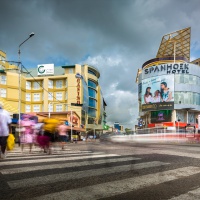 Canon EOS 5D Mark III Review — Spanhoek in Paramaribo (2 sec. exposure)
Canon EOS 5D Mark III Review — Spanhoek in Paramaribo (2 sec. exposure)Canon EOS 5D Mark III Review
Spanhoek in Paramaribo (2 sec. exposure)
 Canon EOS 5D Mark III Review — Krasnapolsky building in Paramaribo (2 sec. exposure)
Canon EOS 5D Mark III Review — Krasnapolsky building in Paramaribo (2 sec. exposure)Canon EOS 5D Mark III Review
Krasnapolsky building in Paramaribo (2 sec. exposure)
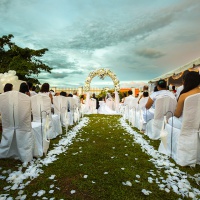 Canon EOS 5D Mark III Review — Wedding Coverage (ISO 1600)
Canon EOS 5D Mark III Review — Wedding Coverage (ISO 1600)Canon EOS 5D Mark III Review
Wedding Coverage (ISO 1600)
 Canon EOS 5D Mark III Review — Wedding Coverage (ISO 16000. Yes 16000.)
Canon EOS 5D Mark III Review — Wedding Coverage (ISO 16000. Yes 16000.)Canon EOS 5D Mark III Review
Wedding Coverage (ISO 16000. Yes 16000.)
 Canon EOS 5D Mark III Review — ISO 400 Shot
Canon EOS 5D Mark III Review — ISO 400 ShotCanon EOS 5D Mark III Review
ISO 400 Shot
 Canon EOS 5D Mark III Review
Canon EOS 5D Mark III ReviewCanon EOS 5D Mark III Review
 Canon EOS 5D Mark III Review — ISO 100 Shot
Canon EOS 5D Mark III Review — ISO 100 ShotCanon EOS 5D Mark III Review
ISO 100 Shot
 Canon EOS 5D Mark III Review — ISO 800 Shot
Canon EOS 5D Mark III Review — ISO 800 ShotCanon EOS 5D Mark III Review
ISO 800 Shot
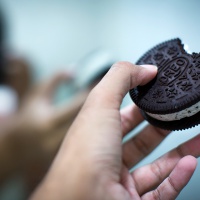 Canon EOS 5D Mark III Review — ISO 3200 Shot
Canon EOS 5D Mark III Review — ISO 3200 ShotCanon EOS 5D Mark III Review
ISO 3200 Shot
 Canon EOS 5D Mark III Review — ISO 6400 Shot
Canon EOS 5D Mark III Review — ISO 6400 ShotCanon EOS 5D Mark III Review
ISO 6400 Shot
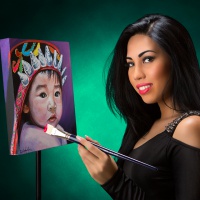 Canon EOS 5D Mark III Review — The Paintress
Canon EOS 5D Mark III Review — The PaintressCanon EOS 5D Mark III Review
The Paintress
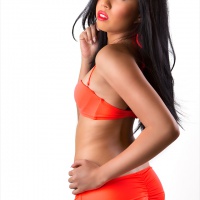 Canon EOS 5D Mark III Review
Canon EOS 5D Mark III ReviewCanon EOS 5D Mark III Review
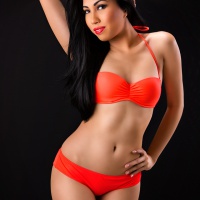 Canon EOS 5D Mark III Review
Canon EOS 5D Mark III ReviewCanon EOS 5D Mark III Review
Updates
Update July 18th, 2012
I made the comment recently that the 22MP 5D Mark III images upsampled to 36MP using good software would look almost as good as the D800 images with regard to the resolution. It seems like people find it hard to believe this. So I took some images from DPReview here, from the D800 and 5D Mark III both at ISO 100 and put together the comparison below to make it convenient for you. Remember: the 5D Mark III image is upsampled to 36MP. See if you can tell which one of the two columns (Camera A and B) is the 5D Mark III and D800.
The point of this comparison is that the difference in resolution on screen is marginal at best when properly upsampling the 5D Mark III images to 36MP. In print this would be even more marginal. Is this marginal difference in resolution worth the slow 4fps framerate on the D800? Is it worth the overall slower camera and workflow? Is it worth the big diskspace eating files and all the hassle that comes with that (memory consumption, slower PC, backups etc.)? In my opinion it’s not. Also, I’ll take a better autofocus system and better high ISO performance any day instead of this marginal advantage in resolution. The 5D Mark III is the better choice here.
Another thing I should mention is that I also had some trouble with the black focus points on the 5D Mark III while shooting at night. It’s difficult to see which focus point is selected in this case. Many have complained about this issue and Canon is currently working on a firmware update that is going to make this less of an issue.
Update July 19, 2012
I covered a wedding last saturday with both my 5D Mark III’s and after that experience I have some more comments. First, the AF system is amazing. In the over 2000 shots I took with both cameras, using lenses such as the 16-35mm f/2.8 L, 85mm f/1.2 L, 100mm f/2.8 L Macro and 8-15mm f/4 L Fisheye, I can tell you I have yet to find one that is out of focus and where it wasn’t my fault. It’s incredible. With previous cameras that I used, it was possible to get AF confirmation and finding out later the focus was off. Not with the 5D Mark III.
Secondly, the metering system could use improvement. Someone asked in the comments below for spot metering linked to the selected AF point, and this is a very valid request. Using the center point to spot meter is difficult when taking action shots and doing events for off center compositions. There’s a thread on DPReview where this is discussed. During the wedding coverage I had to constantly check the LCD to see if the exposure was correct, or if I had to dial in exposure compensation (usually between 1 to 1.5 stops). This needs improvement. I’m hoping that Canon can release a firmware update where the exposure can be checked based on the selected autofocus point only. Right now this functionality is present in the evaluative metering mode, but this also checks other focus points that have achieved (near) focus:
To work with the iFCL metering sensor, the EOS 7D also features a specific metering algorithm. The EOS 7D always measures focus with all AF points regardless of the selected AF mode. During the exposure reading the EOS 7D looks to see which points, in addition to the selected point, have achieved or almost achieved focus. This information lets the camera know which part of the image is the subject. It then takes metering readings from the zones corresponding to the AF points that have achieved (or almost achieved) focus and combines them with readings from all the other zones. This allows for consistent shot-to-shot exposure, even in complex situations – for example, where there are reflections from a model’s glasses.
Canon could perhaps add a custom function that would enable readings just from the selected autofocus point, which would work as spot metering linked to the autofocus point. Not sure if I’m correct here but this is what it seems like to me.
I’ve also been having some discussions below and I want to thank everyone for their contribution in the comments. With regard to the DxOMark measurements, the 5D Mark III performs better with regard to noise, tonal range and dynamic range above ISO 800. You can check the results yourself on the “Measurements” tab on this link. Below are some screenshots for your convenience.
If the 5D Mark III has lower noise at all ISO values compared to the D800, better tonal range at all ISO values, and better dynamic range above ISO 800, then how can DxOMark give the 5D Mark III a lower score compared to the D800? Especially since these measurements do agree with real world data (stills and video). Yet, DxOMark, in their final score for low light/high ISO performance, give the D800 a higher score. How?
Update May 20th, 2014
It appears that you shouldn’t trust the weather sealing of the 5D Mark III. I’ve had a bad experience working with this camera in the rain. For the details please check out this post of mine.
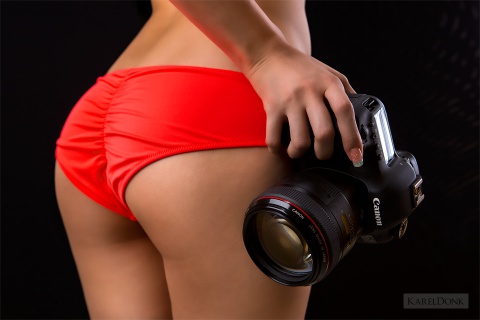

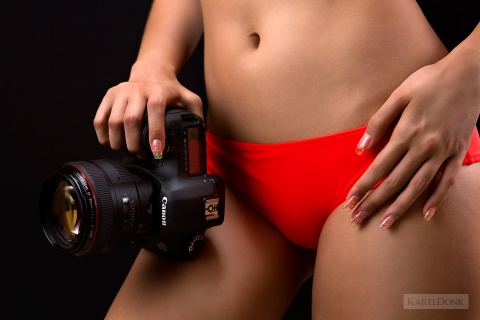
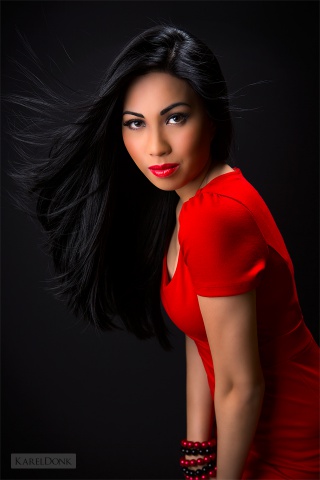
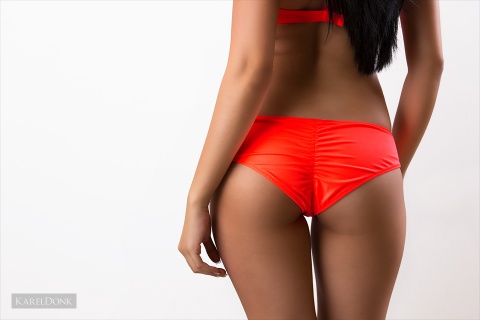
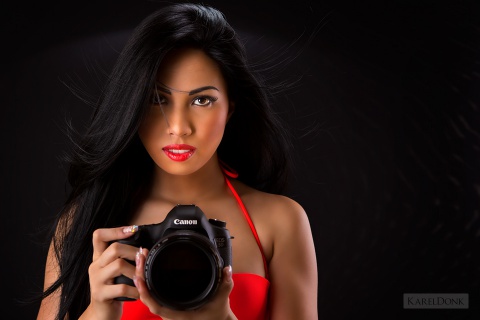
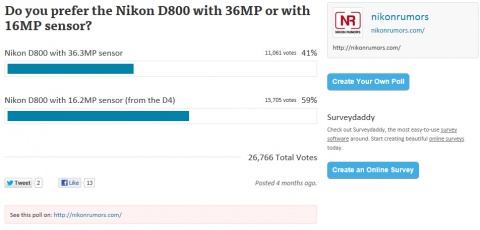
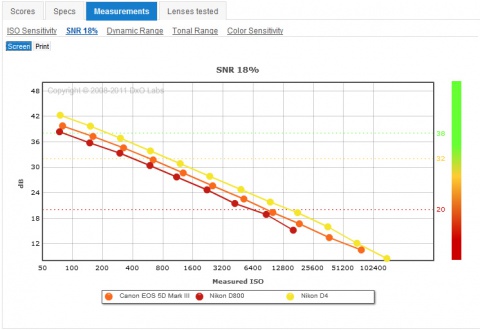
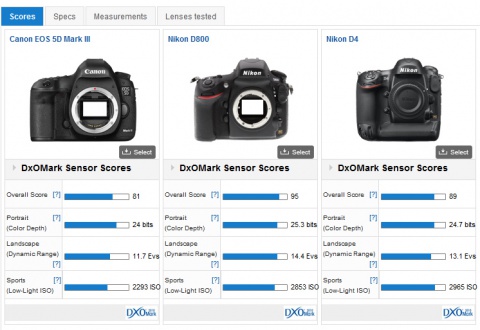
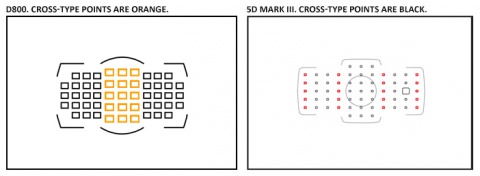


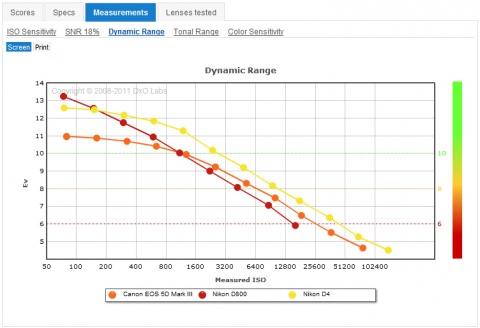
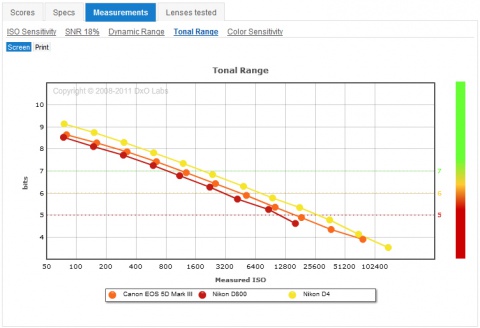

Comments
There are 112 responses. Follow any responses to this post through its comments RSS feed. You can leave a response, or trackback from your own site.